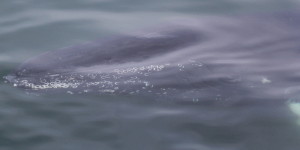Naturalist’s Notebook: April 16 to April 22, 2016
When you whalewatch at this time of year, you should keep two things in mind. First, this is the best time of year to see a North Atlantic Right Whale. And, second, due to the presence of Right whales in Cape Cod Bay and the surrounding north Atlantic, there is a mandatory 10 knot speed limit for all vessels over 65 feet long. Don’t be worried. This speed limit does not interfere with your chances of seeing whales. At this time of the year, there are usually whales within Cape Cod Bay.
The second day of whalewatching, April 16, was windy and chilly. The kind of day that separated real whalewatchers from the people that think whales might be “cute.” Three species of baleen whales were sighted today; Minke whales, Finback whales, and Humpback whales.
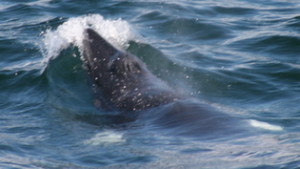
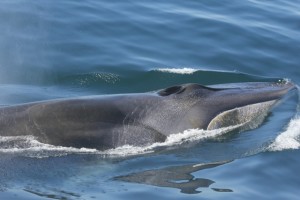
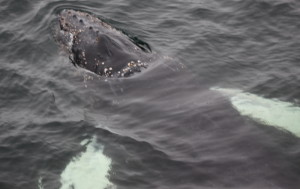
On April 17, the Dolphin VIII was the object of curiousity of not just one or two humpback whales, but four humpback whales. They spent in excess of a full hour swimming back and forth under the boat, rolling over, spyhopping, and flippering. “It was awesome,” said the naturalist that has been whalewatching for the better part of three decades.
.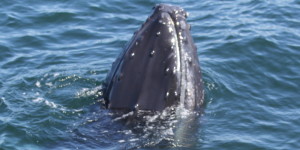
Just a single trip on April 18. There were four species of baleen whales seen today. A Minke whale, a number of Finback whales, a pair of Humpback whales , and a North Atlantic Right whale. One of the Finbacks and both of the Humpbacks allowed us to get good looks at them, giving the passengers a good feel for the shapes and sizes of their bodies. But the Right whale was feeding at the surface.
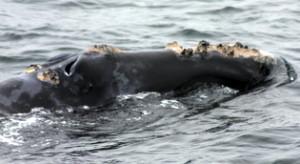
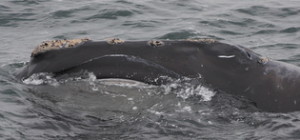
The Dolphin VIII, being a Whale Sense vessel and a responsible whalewatching boat, maintained in excess of the 500 yard buffer zone between our vessel and the animal. (Obviously, the above photos are not from today’s trip.) But there was another boat out there this day. And, though I don’t like point out the stupidity of the operators of other vessels, this operator aimed his vessel directly at the Right whale and only slowed his boat when within thirty-five or forty feet of the whale. In addition, he continued manuevering his engines as the whale dipped beneath the surface. Even if this was a humpback whale (which do not have a 500 yard buffer zone), this guy was way too close to be operating his vessel in such a zig-zag manner around a whale.
If you have your own boat and you want to go see whales, I get it. I just ask that you take a couple of minutes to learn how to view them responsibly. Most of the large whales are protected by the Endangered Species Act and ALL whales, including dolphins and porpoise, are protected by the Marine Mammal Protection Act. There are guidelines that apply to viewing most whales and regulations that apply to viewing Right whales. By all means, go look at the whales. Please keep in mind while you are doing so that you are a guest in their world. For those of you that understand math better than other outreaches, there are less than 500 North Atlantic Right whales still in existence and the human population of this planet is in excess of 7,500,000,000. Just count the zeros if you are in doubt.
John Conlon reports nice looks at a Finback whale named Cyrano on April 19. Unfortunately, I do not have a photo of that whale to show you. He also reports good looks at two other Finwhales on this afternoon’s trip. In case you are new to this world, or you have forgotten, Finwhales are big. Not just a little big. Huge! They are the second largest animals, by weight, that ever lived on this planet. All of those dinosaurs that had really long necks and really long tails had really long necks and really long tails so they didn’t even come close to the weight of a Finback whale. A mature Finwhale will be between sixty and ninety feet long and weigh seventy to one hundred tons. And they are truely impressive as they rise out of the deep. Long and streamlined, they are fast for their size. They can reach and maintain speeds of as much as thirty knots. Think about that for a minute. Before 1870 or 1880, if you were hunting whales, you lowered a row boat from a sailing vessel and rowed up beside the whale you wished to throw your harpoon into. Fast meant they were safe for a long time. Until harpoon cannons that fired harpoons with exploding tips that filled the whale’s body with gas. Now, with steam-powered boats, Finwhales were a target. In less than eighty years, 750,000 Finwhales were slaughtered by commercial whalers.
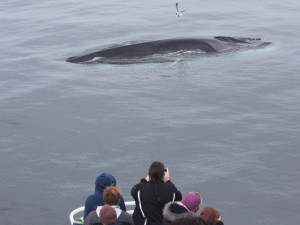
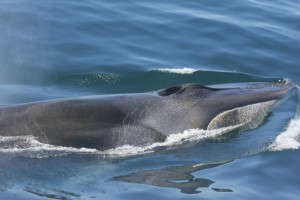
On the afternoon of April 20, the Dolphin Fleet was proud to take students from both the Cardigan School (NH) and the Oxford Academy (CT) to see whales. Dennis Minsky reports seeing both Finback whales and Humpback whales. One of the later was “logging,” a rest behavior. This allows the passengers to get a really good feel of the size and shape of the humpback whale. He also reports that a juvenile humpback breached several times.
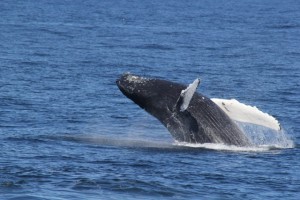
Breaching is thought to be the most energetically expensive behavior in the animal kingdom. If you think about that for just a minute, that means it must be incredibly important. There are a lot of theories as to why whales breach. Most of them make sense. But if we were to think about breaching in terms of what we do, we might have an even better appreciation for just how spectacular it is. Lets face it, in our lives, we each have our own criteria for what makes something so important that we put out the extra effort and spend the extra energy. For some of us, our family is so important that we work nonstop in a soul-sucking job and do so happily, knowing that we are providing for our loved ones. For others, our work is king and we willing deprive ourselves of the things that might take our attention from it. Some of us are about wealth. Some are about love. There are seven and a half billion of us, expending our energy in seven and a half billion ways. But each of us expends his energy most on what is most important to him. Breaching must be incredibly important!
April 21 was a beautiful day. And on this beautiful day, the Dolphin Fleet took school students from the Cape out on the water. Again, there were humpack whales and finback whales. Dennis Minsky reports watching whales approaching the boat repeatedly. When humpback whales are curious about the boat, we need to keep in mind that it is the boat they are reacting to, not us. For us, we are having an interactive experience with the whale but, for the whale, it’s kind of like when we took a bath as a kid and had a toy boat with us. We were figuring out what it was and how it floated. We were checking out how it looked, what color it was, and maybe how it sounded. If the tiny, little animals on that boat had been as big as sea monkeys, we still would not have noticed them. We were busy with the boat.
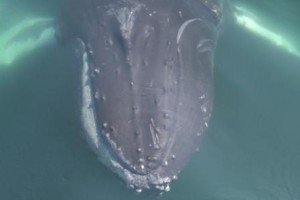
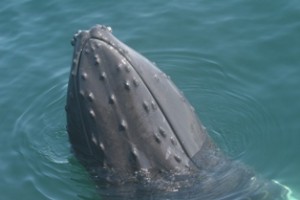
The same thing is kind of true with whales. And that’s not to take away from any experience a passenger has had on a whalewatch. When it comes to that, your experience is what’s important. We only conserve what we love, we only love what we understand, and we understand only what we are taught. We have all heard these words and there is an immense amount of truth to them. Remember that what we learn by experience is far more fundamental to us than what we learn from books.
On April 22, the Dolphin VIII ventured out of the bay and to the southern end of Stellwagen Bank. Juvenile humpback whales have been in the bay since the start of whalewatching. Today, there were mature humpback whales feeding on the bank. Some humpbacks mature fairly early. Large humpbacks may be mature by the age of five. Others take more time, perhaps seeing a dozen years before they are ready to mate.
If you have been whalewatching in the past, you have probably heard your naturalist refer to this area as a restaurant for whales. We go to a restaurant to eat and, maybe, for a little social interaction. And for whales it is pretty much the same. If there is an all you can eat, most of us will take our time and go back once or twice to have our fill, socializing with our friends during the interum. In a whale’s world, the all you can eat might last six months. And, rather than having just one or two friends at the restaurant, they might have eighty. But the analogy is still good.

